 |
| Aprilia RS 125 cylinder barrel codes |

===================================================================
Presented at the show in Milan in November 1992, the RS Extrema Pro Sports officially takes the place of the Futura Sport ProSport Production championship winning season at the end of the title in the under-21 category with Roberto Locatelli and over 21 with Giacomo Guidotti.
The '93 Pro Sports keeps the color replication introduced with the Extrema Reggiani Replica '92, but from which it differs in the presence of written 'pro Sports' and fairing of pintail, port-number tables for black, black and mud for looking for purple.
The price of 8,720,000 lire, and includes a special kit provided pro Sports since April and includes a full exhaust system designed by Giannelli and a lever to set in motion that allows you to use the gears inside the starter already engine and then remove the starter.
From a technical perspective, the interventions made by Aprilia and are consistent for the first time on an eighth of a liter Aprilia are also mounted adjustable forks and Marchesini wheels special. Among the actions we see:
> Always Marzocchi inverted fork with 40 mm, but with the ability to adjust the rebound damping with adjustable focus ring on the stem of six positions on the right.
> Boge rear shock equipped with numerous adjustment possibilities for the rebound, the rebound damping and spring preload, of course. Very interesting is the possibility to vary the distance of the shock itself, which allows to obtain the most appropriate structure to the driver by changing the weight distribution is 52% and 48% front to rear in standard configuration.
> Wheels Marchesini help reduce the weight of 1.5 kg and 2.6 kg at the front and rear. The size of the wheels is slightly lower than the RS standards are adopted and MP 7 Sport Pirelli racing in the following dimensions: 100/80 ZR 17 front and 140/60 ZR 17 rear.
> 223610 heat derived from the Future Group SP '92 and worked by hand to minimize tolerances.
> Carburettor Dell'Orto PHBH 28 regulatory
> New mapping for the electronic
> Clutch more robust and equipped with an additional hard
> Gears reinforced components
===============================================================================
The cylinder identified by the code 220L ( 223615 ) is a cylinder for Rotax 122 for the SP preparations. Is part of a kit sold directly from Aprilia, available by presentation of the pilot's license (although in reality it does not work exactly like that ...). Represents an alternative to the original racing 220H .
Index
1 Differences from the 220H
2 Scheme of the ports
3 The exhaust
4 boosters
5 The main racking
6 The secondary decanting
7 The fifth transfer
8 The inlet
Differences with the 220H
The differences between them are minimal, and are obtained only through a different process for machine tool parts. Ducts, their number, their shape, their size in the barrel are perfectly identical. The differences from the version 220H can be summarized as:
Processing of the shelf: the cylinder 220L 0.2 mm has more material on the shelf.
Surface machining head: here the 220L is 0.5 mm longer "short" of the 220H , "automatic" increases the compression ratio .
The share of "absolute" between plans and head cover is therefore 91.4 mm (-0 / +0.5).
As you can see the difference by its standard version is not as abysmal as many would have you believe. Certainly, the 220L is a good basis for elaboration, but with the 220H you can get the same results, only with a little more work.
Pattern of lights

The simple diagram above will help you better understand what we're talking about lights. In reality, the shapes are different, of course.
LIGHT OF DISCHARGE: 63.35 + / -0.2.
BOOSTER (SIN & DEX): 58.35 + / -0.3.
1, TRANSFER (SIN & DEX): 48.75 + / -0.3.
2 nd TRANSFER (SIN & DEX): 48.35 + / -0.3.
5 ° TRANSFER: 48.65 + / -0.4.
Boosters, main and secondary decanting may have with each other (left and right) a maximum difference in height of 0.3 mm (tolerance).
The exhaust
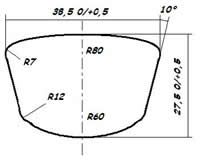
The exhaust port is 38.5 mm wide, with a tolerance of -0 / +0.5 mm. And 'High 27.5 mm, again with a tolerance of -0 / +0.5 mm. The radius of the top is 80mm, bottom 60mm. The upper corners have a radius of 7 mm, while those less than 12mm. The vertical walls are tilted outward (and upward) of 10 °. The shape is so vaguely trapezoidal, with the shorter side at the bottom.
The boosters
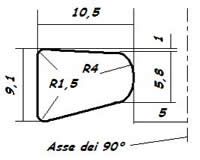
The boosters are 10.5 mm wide, 9.1 mm high in the upper part (toward the exhaust port) and 5.8 mm in the lower part. The upper side is inclined, and the difference in height between the side "light waste" and side "decanting" is 1mm, with the top facing the drain. The radius of the vertical wall (which, however, is almost rounded) side of "racking" is 4mm. The absolute positioning of the light along the wall is on the vertical axis through 90 ° left and right from the centerline of the exhaust ports and intake (basically the path that makes the plug with the piston going up and down), and is 5mm from the vertical edge. The radii of the top and bottom side of "light waste" are worth 1.5 mm.
The main racking

The main transfer ports are roughly rectangular with the distinction of having the curved bottom side up, on the side facing theexhaust port, with a radius of 80mm. The upper side is instead perfectly horizontal. The width is a little 'complicated to calculate, even here the reference is to start the vertical axis that is talked about before. This axis cuts the light into two parts: the vertical wall adjacent to the secondary transfer is set at 8 mm from the axis mentioned before. The radii top and bottom of this side are equal and are worth 2.5 mm. The height of the light in this area is 13.05 mm. The side facing the exhaust port is instead made up of two beams of 5 mm, joined by a very short straight section tilted slightly: from a height of 9.3 mm, this cross a vertical straight section of 14.5 mm from the famous axis 90 °. In the upper zone this value is reduced to 13.1 mm.
The secondary decanting
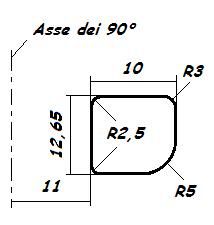
The secondary decanting after all have a fairly simple form, vaguely square, wide and 10mm high and 12.65 mm with radii adjacent to the main transfer ports of 2.5 mm in the area facing the rays pouring 5 ° above and apply 3mm 5mm below. The position always refers to the famous axis at 90 °: in particular, the vertical wall adjacent to the main transfer ports is set at 11mm from the axis.
The fifth transfer
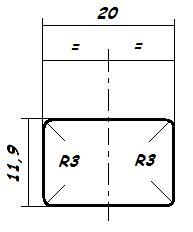
5 ° The transfer has a rectangular shape with rounded corners, all with a radius of 3mm. It has a width of 20mm, divided equally to left and right of the vertical axis of the aspiration and the height is 11.9 mm.
The inlet

Below 5 ° to transfer the inlet port is located, oval-shaped. And '20.4 mm wide and 30mm high, also symmetric about its vertical axis. The rays of the upper and lower 25mm worth, in turn connected by four beams (two right and two left) 9mm. In this case, the lower edge of the light going to affect the plot. The 220H is 2.15 mm from the casing, the 220L to 2.35 mm. We note that even here the difference is only 0.2 mm, as with all other lights: once more clear sign that all are placed in the same position (between them.)
see more Aprilia RS 125 posts here







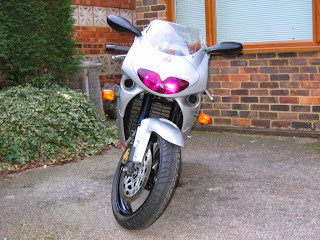












No comments:
Post a Comment